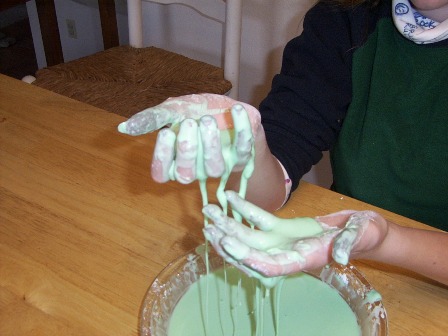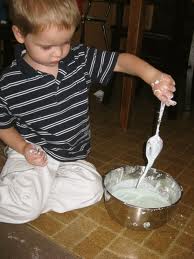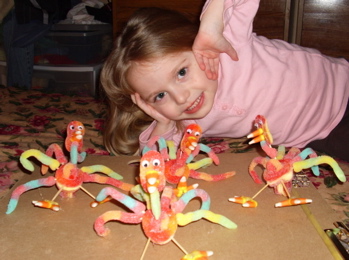In my last post,on creative home schooling ideas I talked about items in your kitchen that would be inspiring in your closet. For the next few blogs I am going to show you that what we think of as play can be and in fact is learning for a child. I also want to show you how to take an idea and use The Spark Station to provide days of interest and fun.
The first item on the kitchen list was cornstarch. I have used this fun corn starch idea with children for over 30 years but I never knew why cornstarch behaves the way it does. So recently I did some internet sleuthing and here is what I found.
Mix a box of cornstarch with water in a bowl. When you mix the cornstarch with water you want it to have the consistency of honey. One box of cornstarch takes approximately 1 to 2 cups of water. You will have to work a bit to get the consistency just right.
When it is mixed you can show your kids a few things about it. Have them sink their hands into the bowl of “cornstarch quicksand” and notice its unusual consistency. Compare what it feels like to move your hand around slowly and then very quickly. You can’t move your hand around very fast! In fact, the faster you move your hand, the more like a solid the cornstarch becomes. Sink your entire hand into the goo and try to grab the fluid and pull it up. That’s the sensation of sinking in quicksand! Skim your finger on the top of the cornstarch mixture. What do you notice? Grab a fist full and squeeze across. What happens? Release the pressure on the mixture in your hand. Now what happens? Roll the fluid between your palms to make a ball.
The cornstarch and water mixture acts like a solid sometimes and a liquid at other times. This concoction is an example of a suspension – a mixture of two substances, one of which is finely divided and dispersed in the other. In the case of the cornstarch quicksand, it’s a solid dispersed in a liquid.
Viscosity is how easily a liquid will flow. Water and honey are both liquids but they certainly flow differently. Sir Isaac Newton said that viscosity is a function of temperature. If you heat honey it flows better than when it is cold. The cornstarch and water mixture and quicksand are both examples of non-Newtonian fluids because their viscosity changes when force is applied, not when heat is applied.
Quicksand is just a soupy mixture of sand and water, where the sand is literally floating on water.
Ok, let me show you how to use this project in your family learning time. Let’s say you have 4 children ages, 2, 5, 8, and 12. Put a box of corn starch in the closet, unopened, in a bowl. Put an index card with the website address on it into the bowl. Place a children’s book about Sir Isaac Newton next to the bowl or under it. Add a book on quicksand or swamps. Have a plastic bag of small plastic animals, including some found in swampy areas. Have a recipe of how to make “cornstarch quicksand” in the bowl.
When the closet is opened one of your children will ask you, “Mom what is this”. The best answer is “Cornstarch, check it out”. Then wait! Let them get the bowl out. Let them check out the contents. They will probably ask for help. Just direct them where to find what they need. If they need help reading the directions help them. Let them make it and experiment with it.
They may look at the books alone or ask you to read to them. Talk with them about what they are reading, what they are experiencing. Share your thoughts. You have been a student yourself and so when they ask you why or how it does what it does you can share what you have learned or you can take them on a journey and help them discover the answers. Have a conversation. Let it go where it goes without a preplanned agenda. They may want to take the cornstarch out to the sand box and make a swamp with plants and animals. Let them. (Add a few drops of food color for more fun)
While the older two (or three) are doing the suggested experiments and others they will think of, you pour a bit on the table and let your 2 and 5 year old just play.
The next day you can add a pudding or cookie recipe. After a day or so you can add a recipe for cornstarch play dough or pre-made play dough depending on the ages and interests of your children.
Playdough
2 c. white flour
1 c. salt
½ c. cornstarch
1 Tb. Alum
1 Tb. Oil
2 c. colored water
Put all dry ingredients in a large pan and stir together well. Add all liquid ingredients and stir well. Place on low heat stirring constantly until it looks like clay. You will be able to tell. Take it out of the pan and knead. Keep in a container with a lid. Alum is a must have ingredient. (buy it in any grocery store in the spice aisle) It is a drying agent and keeps the dough from becoming sticky. This will keep a long time if kept in an air-tight container. You can use baby oil or cooking oil or glycerin. Eventually the cooking oil will go rancid but usually the clay has been played into oblivion long before that. Baby oil will scent the clay.
There are many other ways that you can use cornstarch over the next few days or weeks. In the next blog I will give you more ideas and recipes.
Clean up is easy. Cornstarch dries and can be vacuumed up like any powder; if there is a bit left just take a damp cloth to it. The cornstarch and water will not stay mixed long term so if you dispose of it, don’t pour it in your sink as it can cause a clog. If you save it just put it into a zip lock bag. That is also how to dispose of it.
Can you see how much fun your children will have learning new things about a new substance…all from utilizing your Spark Station!
Possibly Related Posts:
- Top 10 Educational Apps for Kids
- 5 Ways to Help Your Child Think Like a Scientist
- Best Apps For Homeschool – Guest Post
- STUCK! Get help!!
- Inspiring Learning








{ 0 comments… add one now }